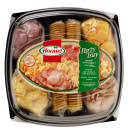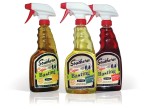Not so Smart Choices?
Study: Consumers to stick with private label brands
Kraft, Coca-Cola support incentive-based recycling in Atlanta
Hormel party trays square off, go green
Barbecue sauce bottle looks like spray cleaner

in canned soups, juice, more
by Rick Lingle
Executive Editor
It appears that packaged foods are still in hot soup over Bisphenol A (BPA), and so is the Food and Drug Administration, according toConsumer Reports.
The magazine’s latest tests of canned foods, including soups, juice, tuna, and green beans, have found that almost all of the 19 name-brand foods tested contain measurable levels of BPA. The new findings show that BPA can be found in a diverse assortment of canned foods including those labeled "organic," and in some foods packaged in "BPA-free" cans. Tests of a few comparable products in alternative types of packaging showed lower levels of BPA in most, but not all cases. The results are reported in the December 2009 issue and available atwww.ConsumerReports.org.
“The findings are noteworthy because they indicate the extent of potential exposure,” says Urvashi Rangan, director of technical policy at Consumers Union, the nonprofit publisher ofConsumer Reports.“Children eating multiple servings per day of canned foods with BPA levels comparable to the ones we found in some tested products could get a dose of BPA near levels that have caused adverse effects in several animal studies.”
Rangan also took aim at the Food and Drug Administration: “The lack of any safety margin between the levels that cause harm in animals and those that people could potentially ingest from canned foods has been inadequately addressed by the FDA to date.”
FDA is expected to announce the findings of its most recent reassessment of the safety of BPA by the end of this month. BPA has been linked to a wide array of health effects including reproductive abnormalities, heightened risk of breast and prostate cancers, diabetes, and heart disease.
Consumer Reportstested three different samples of each canned item for BPA and found:
• Canned Del Monte Fresh Cut Green Beans Blue Lake had the highest amount of BPA for a single sample in its tests, with levels ranging from 35.9 parts per billion (ppb) to 191 ppb.
• Average amounts in tested products varied widely. In most items tested, such as canned corn, chili, tomato sauce, and corned beef, BPA levels ranged from trace amounts to about 32 ppb.
• Nestlé Juicy Juice in a can averaged 9.7 ppb of BPA, but there were no measurable levels in the samples of the same product packaged in juice boxes.
TOP DEVELOPMENTS
Not so Smart Choices?The industry-supported Smart Choices Program announced in late October that it would voluntarily postpone active operations and not encourage wider use of the logo at this time by either new or currently enrolled companies. The move followed closely an announcement by FDA that it would develop standardized criteria for future front-of-package (FOP) nutrition and shelf labeling. The Smart Choices Program was partly in response to governmental calls for a more uniform, voluntary, front-of-package labeling program. However, nutritionists complained that some sugary cereals and high-salt foods display a "Smart Choices" checkmark on their packages. The announcement was welcomed by Mike Hughes, chair of the Smart Choices Program and vice president for science and public policy at the Keystone Center: “It is [now] more appropriate to channel our information and learnings to the FDA to support their initiative.”
Study: Consumers to stick with private label brands
A yearlong shopper experience study currently underway by The Integer Group and M/A/R/C Research revealed those consumers who are buying more private label brands say they won't return to name brands in the foreseeable future. Only 37% of consumers surveyed said name brands are more reliable, and 39% believe name brands are better quality products. Eighty-four percent of consumers surveyed think brand names are more expensive. This data suggests that brand names must offer incentives to consumers or risk losing them to private labels indefinitely. Although the study shows consumers are most concerned about price, there are some brands such as Kraft and Coca-Cola that shoppers say they are least likely to trade for store brands. Consumers also consider Kroger, Walmart, and Target to be stores that carry the best private-label brands.
Kraft, Coca-Cola support incentive-based recycling in Atlanta
Ten thousand households throughout Atlanta, Ga., will soon be rewarded for their curbside recycling efforts in a pilot program. Rehrig Pacific has collaborated with key sponsor Coca-Cola Recycling, LLC and rewards partner RecycleBank to offer residents a rewards and loyalty program that incentivizes household recycling. The effort is intended to encourage proper recycling habits, boost recycling participation, reduce the amount of recyclables being sent to area landfills and save taxpayer money as an opportune way to move towards a greener, cleaner Atlanta. City officials are confident they will see a rise in recycling volumes and a decrease in waste tonnages. In addition to the benefit to the environment, the rewards program will give residents and local businesses a needed economic boost. Participants will earn RecycleBank Points with every pickup that can be redeemed for rewards, gift cards, groceries, and products. Partners include Coca-Cola, Kraft Foods, Publix and local partners.

NEW PACKAGES
Hormel party trays square off, go greenHormel Foods has revamped the packaging of its party trays to reduce material and otherwise add more appeal. The trays of cold cuts, cheese and crackers have been changed from round to elliptical with corners, a shape that uses less plastic. The shrink wrap covering the exterior was replaced with tamper-evident tape on two of the side panels, which Hormel estimates will save about 100,000 pounds of film a year. The corrugated cases have been downsized, using less corrugated and allowing three more cases per pallet. In addition, product graphics are now inlaid on the interior of the tray’s lid to help achieve a fresher, deli-like feel. This revamp, which was rolled out in the fall, is the first wave of a packaging revamp that will affect all of Hormel’s party tray products.

A barbecue sauce company is using a familiar bottle in an unfamiliar way. An oblong PET bottle with trigger sprayer, most often used for cleaners and other household chemicals, is being used by Southern Bar-B-Que Sauce Inc., Jennings, La, for its basting sauces. The stock bottles and sprayers, fromTricorBraun, allow wide, even coverage of large targets like rib racks or whole chickens. Southern Bar-B-Que uses the 16-ounce bottles for its three basting blends (Zesty Garlic Herb, Jalapeño Butter and Original Bar-B-Que). The bottles have a 28/400 neck finish, and the labels are printed on pressure-sensitive, laminated paper.
